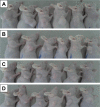Arginine, glycine, aspartic acid peptide-modified paclitaxel and curcumin co-loaded liposome for the treatment of lung cancer: in vitro/vivo evaluation
- PMID: 29731631
- PMCID: PMC5927341
- DOI: 10.2147/IJN.S157746
Arginine, glycine, aspartic acid peptide-modified paclitaxel and curcumin co-loaded liposome for the treatment of lung cancer: in vitro/vivo evaluation
Abstract
Purpose: In this study, a novel arginine, glycine, aspartic acid peptide (RGD)-modified paclitaxel and curcumin co-loaded liposomes were developed to evaluate their antitumor activity in vitro and in vivo.
Materials and methods: Co-loaded liposomes were prepared using the solvent evaporation method. The particles had spherical shapes under electron microscopy with sizes <130 nm.
Results: By comparison with the free drug, RGD-modified paclitaxel and curcumin co-loaded liposomes and paclitaxel and curcumin co-loaded liposomes have sustained-release properties in vitro. In vivo, there was no significant difference in pharmacokinetic parameters between the RGD-modified paclitaxel and curcumin co-loaded liposomes and paclitaxel and curcumin co-loaded liposomes. A strong green fluorescence was observed in the cytoplasmic region after incubation of RGD-modified paclitaxel and curcumin co-loaded liposomes for 2 h. RGD-modified paclitaxel and curcumin co-loaded liposomes showed a superior antiproliferative effect on A549 cells with a possible mechanism that suppressed the multidrug resistance phenomenon and exhibited a clear synergistic effect.
Conclusion: The results indicate that RGD-modified paclitaxel and curcumin co-loaded liposomes had a better antitumor effect in vivo than the non-modified LPs. These results indicate that RGD-modified co-loaded liposomes are a promising candidate for antitumor drug delivery.
Keywords: arginine; aspartic acid peptide; cell uptake; curcumin; cytotoxicity study; glycine; in vivo anti-tumor study; liposome; paclitaxel.
Conflict of interest statement
Disclosure The authors report no conflicts of interest in this work.
Figures







Similar articles
-
RGD-based strategies for improving antitumor activity of paclitaxel-loaded liposomes in nude mice xenografted with human ovarian cancer.J Drug Target. 2009 Jan;17(1):10-8. doi: 10.1080/10611860802368966. J Drug Target. 2009. PMID: 19016068
-
RGD peptide-modified, paclitaxel prodrug-based, dual-drugs loaded, and redox-sensitive lipid-polymer nanoparticles for the enhanced lung cancer therapy.Biomed Pharmacother. 2018 Oct;106:275-284. doi: 10.1016/j.biopha.2018.06.137. Epub 2018 Jun 28. Biomed Pharmacother. 2018. PMID: 29966971
-
Multifunctional Tandem Peptide Modified Paclitaxel-Loaded Liposomes for the Treatment of Vasculogenic Mimicry and Cancer Stem Cells in Malignant Glioma.ACS Appl Mater Interfaces. 2015 Aug 5;7(30):16792-801. doi: 10.1021/acsami.5b04596. Epub 2015 Jul 22. ACS Appl Mater Interfaces. 2015. PMID: 26173814
-
Liposomal curcumin and its application in cancer.Int J Nanomedicine. 2017 Aug 21;12:6027-6044. doi: 10.2147/IJN.S132434. eCollection 2017. Int J Nanomedicine. 2017. PMID: 28860764 Free PMC article. Review.
-
Curcumin Combination Chemotherapy: The Implication and Efficacy in Cancer.Molecules. 2019 Jul 10;24(14):2527. doi: 10.3390/molecules24142527. Molecules. 2019. PMID: 31295906 Free PMC article. Review.
Cited by
-
Co-Delivery of 5-Fluorouracil and Paclitaxel in Mitochondria-Targeted KLA-Modified Liposomes to Improve Triple-Negative Breast Cancer Treatment.Pharmaceuticals (Basel). 2022 Jul 17;15(7):881. doi: 10.3390/ph15070881. Pharmaceuticals (Basel). 2022. PMID: 35890181 Free PMC article.
-
Evaluation of the Biodistribution of Arginine, glycine, aspartic acid peptide-modified Nanoliposomes Containing Curcumin in Rats.Iran J Biotechnol. 2022 Apr 1;20(2):e2990. doi: 10.30498/ijb.2021.272168.2990. eCollection 2022 Apr. Iran J Biotechnol. 2022. PMID: 36337060 Free PMC article.
-
Peptide-functionalized liposomes as therapeutic and diagnostic tools for cancer treatment.J Control Release. 2021 Jan 10;329:624-644. doi: 10.1016/j.jconrel.2020.09.055. Epub 2020 Oct 1. J Control Release. 2021. PMID: 33010333 Free PMC article. Review.
-
Anti-Cancer Properties of Flaxseed Proteome.Proteomes. 2023 Nov 16;11(4):37. doi: 10.3390/proteomes11040037. Proteomes. 2023. PMID: 37987317 Free PMC article. Review.
-
Combination Therapy Using Polyphenols: An Efficient Way to Improve Antitumoral Activity and Reduce Resistance.Int J Mol Sci. 2022 Sep 6;23(18):10244. doi: 10.3390/ijms231810244. Int J Mol Sci. 2022. PMID: 36142147 Free PMC article. Review.
References
-
- Kramer I, Heuser A. Paclitaxel pharmaceutical and pharmacological issues. Eur Hosp Pharm. 1995;1:37–41.
-
- Shishodia S, Sethi G, Aggarwal BB. Curcumin: getting back to the roots. Ann N Y Acad Sci. 2005;1056:206–217. - PubMed
MeSH terms
Substances
LinkOut - more resources
Full Text Sources
Other Literature Sources
Medical

